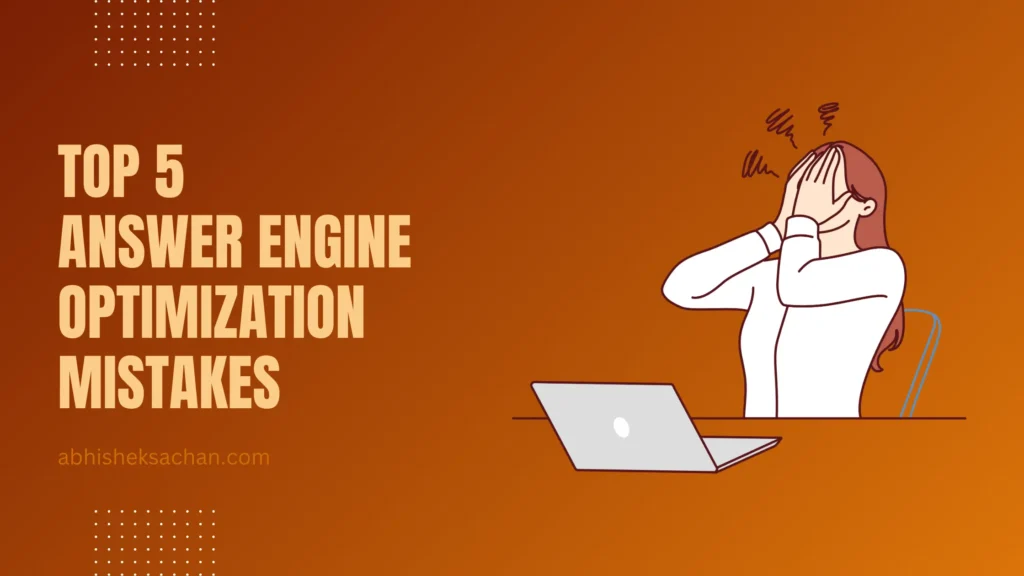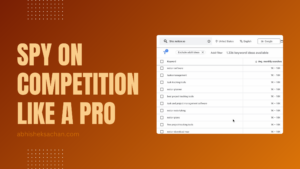In AI era, search engines are evolving into answer engines to cope up with the shift. Now optimizing for visibility in featured snippets and voice search is no longer optional, but it’s a strategic advantage. Answer Engine Optimization (AEO) is the next frontier in organic search, focused on delivering direct, concise, and valuable answers to user queries.
Like any emerging discipline, AEO comes with its own set of challenges. For startup founders avoiding key mistakes in AEO can save time, enhance discoverability, and help establish authority in niche domains.
Below, we outline the most common mistakes in AEO and the best practices to ensure your AI product stands out in search.
Mistake 1: Treating Answer Engine Optimization(AEO) Like Traditional SEO
What Goes Wrong:
Many AI startup founders mistakenly apply traditional SEO tactics without recognizing the shift in user behavior. Unlike general keyword strategies, users engaging with AI research tools often ask specific, intent-rich questions.
Best Practices:
- Focus on user intent, not keyword volume.
- Target research-driven queries related to your niche (e.g., “What is the latest research on climate policy impact?”, “How does AI summarize scientific papers?”).
- Use tools like AlsoAsked and Google’s “People Also Ask” to uncover common research-related questions your users are asking.
Mistake 2: Ignoring Structured Data Markup

What Goes Wrong:
Without structured data, your content (e.g., AI-generated research summaries, topic overviews, FAQ insights) is less likely to appear in featured snippets or rich results. In SEO Checklists, snippets are at low priority but in AEO snippets have got into front row.
Best Practices:
- Add schema markup like FAQPage or QAPage to pages where your AI answers research questions.
- Use Schema.org and validate with Google’s Rich Results Test.
- Apply structured data to landing pages and research summaries where appropriate to increase visibility.
Mistake 3: Neglecting Voice Search Optimization

What Goes Wrong:
If your product helps users explore research through conversational interfaces or voice input, failing to optimize for natural language reduces your potential in voice-first environments.
Best Practices:
- Write summaries and key takeaways in a natural, conversational tone.
- Frame content using clear questions and short answers (e.g., “How does AI identify research gaps?”).
- Include location-based queries if relevant to your vertical (e.g., local policy, regional climate studies).
- Test your responses using voice tools like Google Assistant to ensure clarity and relevance.
Mistake 4: Underestimating the Value of FAQ Pages
What Goes Wrong:
Founders often focus only on technical product documentation, ignoring the power of FAQs in targeting long-tail, user-centric questions about how their AI tool works or solves research challenges.
Best Practices:
- Build a robust FAQ page with real-world user questions (e.g., “How does your AI handle bias in academic research?”).
- Use structured data to improve the chances of being featured in answer boxes.
- Pull common questions from customer support, user interviews, or usage patterns within your AI platform.
Mistake 5: Failing to Measure and Iterate AEO Performance
What Goes Wrong:
If you’re not measuring which queries lead to featured snippets or tracking performance across research-related keywords, you’re flying blind. Many AI startups treat content as a one-off asset.
Best Practices:
- Use Google Search Console to track impressions and CTR for informational queries related to your niche.
- Monitor featured snippet performance with tools like Ahrefs or SEMrush.
- Regularly update AI-generated summaries and insights to reflect the latest research trends and improve ranking potential.
Conclusion: AEO as a Core Growth Strategy for AI Startups
As AI becomes a more prominent way for users to interact with complex data, Answer Engine Optimization ensures that your product’s insights and answers surface exactly when your target users are searching.
By avoiding these common AEO pitfalls and implementing best practices tailored to AI research tools, you enhance user trust, expand your visibility, and position your startup as a reliable authority in your domain.
Next Steps
- Audit your AI-generated content for snippet-readiness.
- Build a content calendar around high-intent research queries.
- Apply structured data and conversational formatting across your site.
AEO isn’t just about traffic — it’s about being the answer your users trust when they need expert insight most.
Frequently Asked Questions
What is Answer Engine Optimization and how does it differ from traditional SEO?
Answer Engine Optimization (AEO) is the process of creating content that directly answers user queries to improve visibility in answer boxes, voice search, and featured snippets. Unlike traditional SEO, which focuses on keyword rankings, AEO centers on fulfilling search intent through clear, concise responses.
How do I optimize my content to appear in Google’s featured snippets?
Structure your content using clear headings, question-and-answer formats, and concise responses (typically 40–60 words). Use bullet points or numbered lists where appropriate, and ensure that your content directly addresses specific search queries.
What types of structured data help with Answer Engine Optimization?
Structured data such as FAQPage, HowTo, and QAPage schemas are highly effective for AEO. They help search engines understand your content’s structure and context, improving your chances of appearing in rich results.
Why is voice search important for AEO, and how can I prepare my content for it?
Voice search is growing rapidly and relies on conversational, natural language. To optimize for it, use a friendly, conversational tone, answer common spoken questions clearly, and include location-specific terms if applicable.
How does Google select content for answer boxes and snippets?
Google selects content that best matches the user’s query with a clear, concise, and well-structured answer. Content that appears near the top of a page, includes relevant keywords, and is properly formatted has a better chance of being selected.
What are the common mistakes that prevent content from appearing in featured snippets?
Common mistakes include failing to use structured data, not answering questions directly, writing in a complex or unclear style, and neglecting to format content for readability (e.g., using long paragraphs instead of lists or headers).
Can small or new websites rank in featured snippets using AEO tactics?
Yes. Google prioritizes content quality and relevance over domain authority in many featured snippets. A well-optimized, clearly structured page from a smaller site can compete with larger players if it effectively answers the user’s question.
What are the best tools for tracking and optimizing for AEO?
Useful tools include Google Search Console, Ahrefs, SEMrush, and Surfer SEO. These tools help identify snippet opportunities, monitor performance, and analyze how your content is appearing in search.
How do FAQ pages improve visibility in answer engines like Google and Alexa?
FAQ pages structured with clear questions and concise answers are favored by search engines. When marked up with schema, they help Google and voice assistants quickly understand and surface your content in response to user queries.
How often should I update my content to maintain featured snippet visibility?
Content should be reviewed and updated every 3–6 months to reflect new information, match evolving search intent, and maintain its position in answer boxes. Regular updates signal freshness and relevance to search engines.




